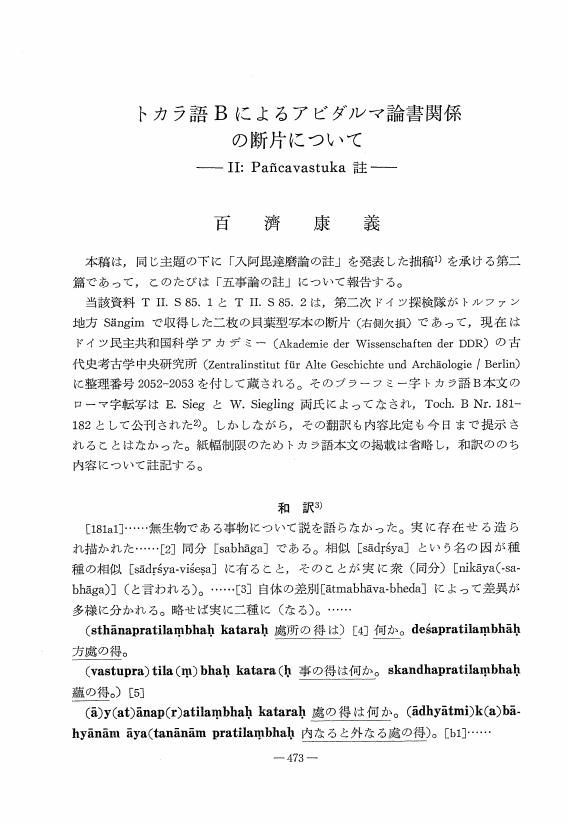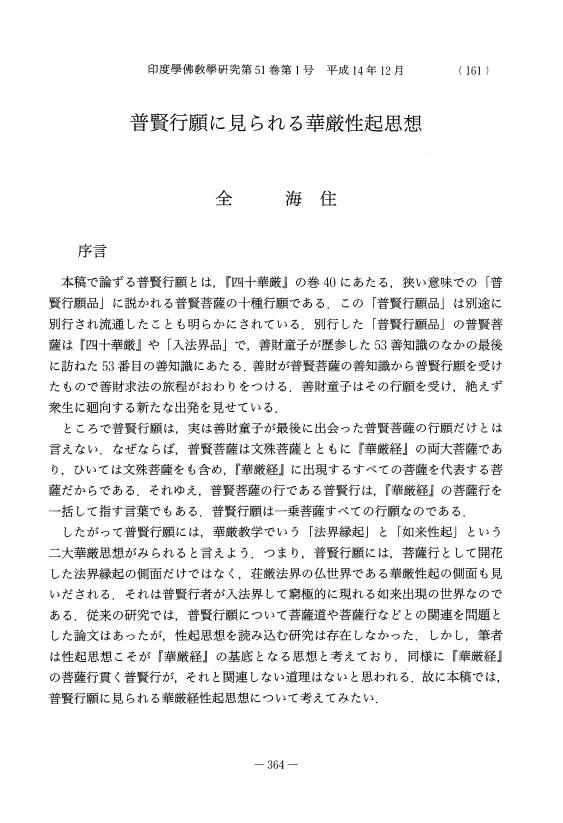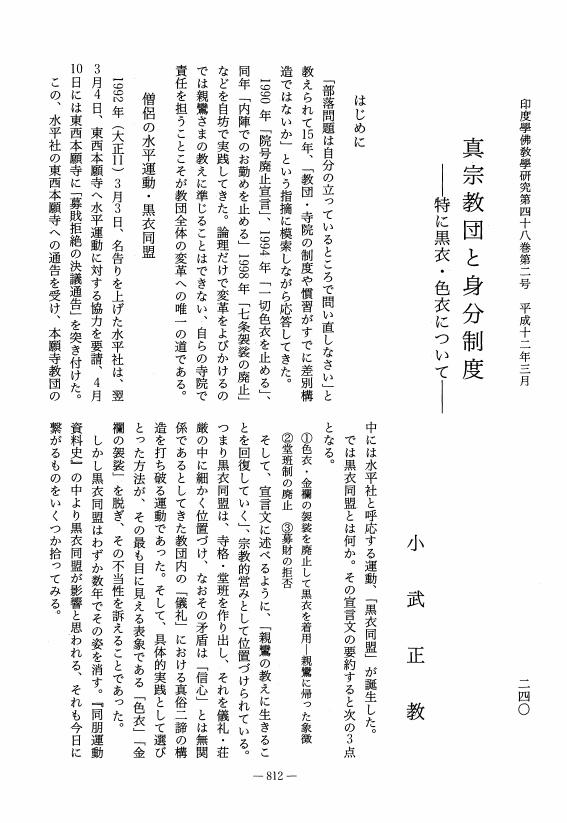1 0 0 0 OA 行基と布施屋
- 著者
- 吉田 清
- 出版者
- Japanese Association of Indian and Buddhist Studies
- 雑誌
- 印度學佛教學研究 (ISSN:00194344)
- 巻号頁・発行日
- vol.26, no.2, pp.730-733, 1978-03-20 (Released:2010-03-09)
- 著者
- 百濟 康義
- 出版者
- Japanese Association of Indian and Buddhist Studies
- 雑誌
- 印度學佛教學研究 (ISSN:00194344)
- 巻号頁・発行日
- vol.32, no.1, pp.473-468, 1983-12-25 (Released:2010-03-09)
1 0 0 0 OA 十念極楽易往集について
- 著者
- 和多 秀乘
- 出版者
- Japanese Association of Indian and Buddhist Studies
- 雑誌
- 印度學佛教學研究 (ISSN:00194344)
- 巻号頁・発行日
- vol.32, no.1, pp.1-10, 1983-12-25 (Released:2010-03-09)
1 0 0 0 OA 日本精神運動と仏教思想 -衛藤即応の所説を中心に-
- 著者
- 工藤 英勝
- 出版者
- Japanese Association of Indian and Buddhist Studies
- 雑誌
- 印度學佛教學研究 (ISSN:00194344)
- 巻号頁・発行日
- vol.48, no.1, pp.129-133, 1999-12-20 (Released:2010-03-09)
1 0 0 0 OA 普賢行願に見られる華厳性起思想
- 著者
- 全 海住
- 出版者
- Japanese Association of Indian and Buddhist Studies
- 雑誌
- 印度學佛教學研究 (ISSN:00194344)
- 巻号頁・発行日
- vol.51, no.1, pp.364-359, 2002-12-20 (Released:2010-03-09)
1 0 0 0 OA 六方礼経の諸本に於けるいくつかの問題 (一)
- 著者
- 瀧藤 尊淳
- 出版者
- Japanese Association of Indian and Buddhist Studies
- 雑誌
- 印度學佛教學研究 (ISSN:00194344)
- 巻号頁・発行日
- vol.27, no.1, pp.160-161, 1978-12-31 (Released:2010-03-09)
1 0 0 0 OA 仏教文献およびジャイナ教白衣派文献におけるアジャータシャトル/クーニカの前生譚
- 著者
- 呉 娟
- 出版者
- Japanese Association of Indian and Buddhist Studies
- 雑誌
- 印度學佛教學研究 (ISSN:00194344)
- 巻号頁・発行日
- vol.62, no.3, pp.1173-1178, 2014-03-25 (Released:2017-09-01)
ブッダ,マハーヴィーラと同時代のマガダ国王として,アジャータシャトル/クーニカは,古代インドの仏教徒,ジャイナ教徒のいずれにとっても重要な人物であった.仏教とジャイナ教の資料比較においても,アジャータシャトル/クーニカがいかにして父親を幽閉し死に至らしめたかという物語については,既に仏教ならびにジャイナ教白衣派所伝の同話の平行関係に関する手厚い議論がなされている.しかしながら従来の研究が,この人物にまつわる他の物語群に充分な注意を払ってきたとは言いがたい.本稿は,仏教・白衣派両ヴァージョンにおけるアジャータシャトル/クーニカの,従来ほとんど触れられてこなかった物語,すなわち復讐心を抱く聖者/苦行者としての彼の前生の物語についての,予備的な調査の報告である.本稿では先ず仏教所伝の二ヴァージョン,すなわち『根本説一切有部律』「衣事」および漢訳『大般涅槃経』(Taisho Nos. 374, 375)所収話を,次いで白衣派所伝の三ヴァージョン(ジナダーサ『アーヴァシュヤカ・チュールニ』,ハリバドラ『アーヴァシュヤ・ティーカー』,ヘーマチャンドラ『トリシャシュティシャラーカープルシャチャリタ』)を検討する.本稿は仏教・ジャイナ教のアジャータシャトル/クーニカ前生譚の比較を通して,アジャータシャトル/クーニカの今生の父への敵意を,彼の前生にその因が見いだしうる一種の報復として,業の観点から説明するという,両ヴァージョンの注目すべき平行を明らかにする.この平行は,アジャータシャトル/クーニカを物語る説話伝承が仏教徒とジャイナ教徒に共有されていた可能性を示唆するものである.さらに本稿は,仏教・ジャイナ教両ヴァージョン間の,ビンビサーラ/シュレーニカへの態度における明白な相違について言及するが,この相違の背景解明は別稿に譲るものとする.
1 0 0 0 OA 阿仏房について
- 著者
- 上田 本昌
- 出版者
- Japanese Association of Indian and Buddhist Studies
- 雑誌
- 印度學佛教學研究 (ISSN:00194344)
- 巻号頁・発行日
- vol.26, no.1, pp.43-48, 1977-12-31 (Released:2010-03-09)
1 0 0 0 OA 雲生洞門と大薩祖梁
- 著者
- 川口 高風
- 出版者
- JAPANESE ASSOCIATION OF INDIAN AND BUDDHIST STUDIES
- 雑誌
- 印度學佛教學研究 (ISSN:00194344)
- 巻号頁・発行日
- vol.32, no.2, pp.603-608, 1984-03-25 (Released:2010-03-09)
1 0 0 0 OA サンスクリットの発音
- 著者
- 中村 元
- 出版者
- Japanese Association of Indian and Buddhist Studies
- 雑誌
- 印度學佛教學研究 (ISSN:00194344)
- 巻号頁・発行日
- vol.28, no.1, pp.10-15, 1979-12-31 (Released:2010-03-09)
1 0 0 0 OA 大乗化の手法-維摩経・仏国品のケース-
- 著者
- 小林 圓照
- 出版者
- Japanese Association of Indian and Buddhist Studies
- 雑誌
- 印度學佛教學研究 (ISSN:00194344)
- 巻号頁・発行日
- vol.52, no.2, pp.832-826, 2004-03-20 (Released:2010-03-09)
1 0 0 0 OA 釈尊の悟りには展開があった
- 著者
- 前田 惠學
- 出版者
- Japanese Association of Indian and Buddhist Studies
- 雑誌
- 印度學佛教學研究 (ISSN:00194344)
- 巻号頁・発行日
- vol.54, no.1, pp.21-24,1237, 2005-12-20 (Released:2010-07-01)
At the age of 35, the founder of Buddhism, the Buddha, attained His Enlightenment in Uruvela. This enlightenment is complete enlightenment as thought by many people. But according to Vinaya Mahavagga I, Buddha attained pathamabhisambuddha at first, then in the second stage he developed his enlightenment even more. After his first sermon, the Order consisted of 61 Arahants, and the Buddha further developed his spiritual development in the first rain retreat. He attained incomparable deliverance (anuttara-vimutti) through mindful concentration (manasikara).Enlightenment under the Bo-tree is to become free from Ignorance (avijja) through knowledge (vijja) which must be called emancipation through insight (pañña-vimutti). After the first sermon five ascetics, Yasa and his 54 friends, attained enlightenment through being set free from desire (tanha), which must be called emancipation through mind (citta-vimutti). Emancipation under the Bo-tree is the first stage of enlightenment, but emancipation through both sides (ubhato-vimutti) is a much higher and deeper enlightenment, which is regarded as anuttara-vimutti.
1 0 0 0 OA 日蓮と「法華験記」
- 著者
- 中尾 正己
- 出版者
- JAPANESE ASSOCIATION OF INDIAN AND BUDDHIST STUDIES
- 雑誌
- 印度學佛教學研究 (ISSN:00194344)
- 巻号頁・発行日
- vol.32, no.1, pp.377-380, 1983-12-25 (Released:2010-03-09)
1 0 0 0 OA 真宗教団と身分制度
- 著者
- 小武 正教
- 出版者
- Japanese Association of Indian and Buddhist Studies
- 雑誌
- 印度學佛教學研究 (ISSN:00194344)
- 巻号頁・発行日
- vol.48, no.2, pp.812-815, 2000-03-20 (Released:2010-03-09)
1 0 0 0 OA 『正法眼蔵』における尽の思想 (一)
- 著者
- 粟谷 良道
- 出版者
- Japanese Association of Indian and Buddhist Studies
- 雑誌
- 印度學佛教學研究 (ISSN:00194344)
- 巻号頁・発行日
- vol.37, no.2, pp.748-751, 1989-03-20 (Released:2010-03-09)
1 0 0 0 OA 真言密教における三劫思想について
- 著者
- 加藤 精一
- 出版者
- Japanese Association of Indian and Buddhist Studies
- 雑誌
- 印度學佛教學研究 (ISSN:00194344)
- 巻号頁・発行日
- vol.18, no.1, pp.258-261, 1969-12-25 (Released:2010-03-09)
1 0 0 0 OA FAS禅その三
- 著者
- 藤吉 慈海
- 出版者
- Japanese Association of Indian and Buddhist Studies
- 雑誌
- 印度學佛教學研究 (ISSN:00194344)
- 巻号頁・発行日
- vol.27, no.2, pp.539-542, 1979-03-31 (Released:2010-03-09)
1 0 0 0 OA 過去佛について
- 著者
- 平野 眞完
- 出版者
- Japanese Association of Indian and Buddhist Studies
- 雑誌
- 印度學佛教學研究 (ISSN:00194344)
- 巻号頁・発行日
- vol.9, no.2, pp.538-539, 1961-03-31 (Released:2010-03-09)
1 0 0 0 OA クリシュナ信仰とアービーラ族 -マハーバーラタにみられるアービーラ族の検討-
- 著者
- 及川 弘美
- 出版者
- Japanese Association of Indian and Buddhist Studies
- 雑誌
- 印度學佛教學研究 (ISSN:00194344)
- 巻号頁・発行日
- vol.41, no.1, pp.497-495, 1992-12-20 (Released:2010-03-09)
1 0 0 0 OA 宋元版禅籍研究 (一)
- 著者
- 椎名 宏雄
- 出版者
- Japanese Association of Indian and Buddhist Studies
- 雑誌
- 印度學佛教學研究 (ISSN:00194344)
- 巻号頁・発行日
- vol.25, no.1, pp.262-265, 1976-12-25 (Released:2010-03-09)

















